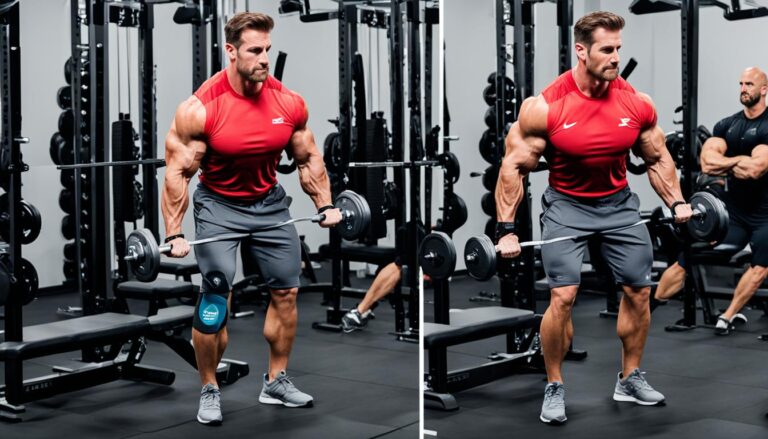Welcome to the ultimate guide on transforming your biceps and achieving superior arm development through targeted barbell workouts. By incorporating these strength training exercises into your fitness routine, you will unlock the potential for enhanced muscle building and increased arm strength. This article will walk you through the benefits, essential exercises, proper techniques, and much more to optimize your bicep training regimen and ensure you achieve your fitness goals.
Key Takeaways
- Effective barbell workouts are crucial for targeted bicep muscle development.
- Strength training with barbells enhances overall arm strength and fitness.
- Proper technique and form are essential to prevent injuries and maximize gains.
- Combining barbell exercises with other workout types can enhance results.
- Track your progress and set realistic goals to stay motivated and improve.
Benefits of Barbell Workouts for Biceps
Engaging in barbell workouts for biceps brings a multitude of benefits that go beyond basic strength training. These exercises not only focus on increasing arm size but also contribute to overall muscle building and improved physical aesthetics.
Muscle Building
Barbell workouts are highly effective for muscle building, particularly when aiming to enhance bicep size. Scientific studies show that barbell training can significantly contribute to hypertrophy. The compound movements performed during these exercises activate numerous muscle fibers, leading to efficient muscle growth.
Increased Strength
Barbell workouts are a cornerstone of weight training, crucial for building superior strength. Expert opinions often highlight that barbell exercises like barbell curls enhance both muscular and tendon strength in the arms. This increased strength, in turn, supports better performance in various sports and daily activities.
Improved Arm Development
When it comes to effective arm development, barbell workouts hold a distinct advantage. Comparative analysis illustrates that barbell exercises contribute significantly to the overall development of arm muscles. This type of weight training isolates the biceps efficiently, resulting in well-defined and robust arms that are aesthetically pleasing and functional.
| Benefit | Explanation |
|---|---|
| Muscle Building | Promotes hypertrophy by engaging multiple muscle fibers. |
| Increased Strength | Enhances both muscular and tendon strength, supporting overall performance. |
| Improved Arm Development | Isolates biceps effectively for better arm definition and strength. |
Incorporating barbell workouts into your routine offers a well-rounded approach to muscle building, turning your bodybuilding efforts into measurable success. With clear advantages in strength and arm development, these workouts are indispensable for anyone looking to achieve optimal results.
Essential Barbell Exercises for the Biceps
Incorporating barbell techniques into your workout regime can significantly enhance the size and strength of your biceps. These exercises are designed to target different parts of the biceps, ensuring comprehensive muscle activation and growth. Let’s delve into three fundamental barbell exercises that can effectively build your biceps.
Barbell Bicep Curls
The barbell bicep curl is a classic exercise for targeting the bicep muscles. It is performed by standing straight, holding the barbell with an underhand grip at shoulder width, and curling the weight towards your chest. This movement stimulates the biceps brachii and helps in building muscle mass efficiently.
Close-Grip Barbell Curls
The close-grip barbell curl focuses on enhancing the peak of the biceps. By narrowing the grip, more emphasis is placed on the inner head of the biceps. This variation is crucial for achieving that well-defined arm look. For accurate execution, grip the barbell closer than shoulder width and perform bicep curls similarly to the standard method. The detailed benefits and variations can be explored further in resources such as these strength training guides.
Reverse Barbell Curls
Reverse barbell curls are ideal for targeting the brachialis, a muscle underneath the biceps that contributes to overall arm thickness. This exercise is performed with an overhand grip, which shifts the focus to different muscle fibers in the forearms and biceps. Integrating reverse curls into your routine can offer a balanced approach to bicep development and strengthen the arms holistically.
These essential barbell exercises provide a comprehensive approach to building stronger biceps. By incorporating these barbell techniques regularly, you can achieve significant muscle growth and improved arm strength.
Proper Form and Technique
Understanding proper form and technique is pivotal in maximizing the benefits of barbell bicep workouts while minimizing the risk of injury. Certified trainers emphasize the necessity of maintaining the correct posture and grip throughout all arm exercises. Here, I will outline the fundamental principles of effective barbell techniques tailored for optimal bicep development.
Firstly, it’s crucial to keep a neutral spine to avoid unnecessary strain on the lower back. Stand with your feet shoulder-width apart and grip the barbell with an underhand grip, ensuring your hands are evenly distanced from the center. A firm, yet comfortable grip is key to executing movements smoothly and efficiently.
The proper execution of arm exercises involves a controlled motion. Avoid using momentum or swinging the barbell; instead, lift and lower the weights with deliberate, slow movements. This not only engages the bicep muscles more effectively but also reduces the risk of injuries.
Moreover, engaging the core throughout barbell techniques stabilizes the body and enhances overall form. This ensures that the biceps are the primary muscles being targeted and worked, allowing for more effective muscle growth and development.
| Aspect | Correct Technique |
|---|---|
| Grip | Underhand, hands shoulder-width apart |
| Posture | Neutral spine, feet shoulder-width apart |
| Movement | Controlled, no swinging |
| Core Engagement | Maintain tight core for stabilization |
Sports scientists further explain the biomechanics of effective barbell techniques, highlighting that full range of motion is essential. Fully extending and contracting the arms during each repetition intensifies the workout, ensuring comprehensive activation of the bicep muscles. By diligently applying these principles, you can enhance your arm exercises and achieve substantial gains in both bicep size and strength.
Common Mistakes to Avoid
Incorporating barbell workouts into your fitness routines can significantly enhance your arm exercises. However, it’s essential to avoid some common mistakes to prevent injury and maximize effectiveness.
Incorrect Grip
An incorrect grip is one of the most frequent mistakes individuals make during barbell exercises. A grip that is too wide or too narrow can lead to inefficient workouts and potential injuries. Ensuring your grip aligns with shoulder width can help distribute weight more evenly and engage the correct muscles.
Using Too Much Weight
Another prevalent error is using too much weight. While lifting heavy can be tempting, especially in fitness routines focused on arm exercises, it is crucial to prioritize proper form over lifting heavier weights. Excessive weight can strain muscles and lead to severe injuries. Starting with manageable weights and incrementally increasing them over time ensures a safe and effective workout.

Lack of Full Range of Motion
Not utilizing the full range of motion is a common mistake that can hinder muscle growth and effectiveness in arm exercises. Performing barbell workouts with a restricted range can reduce the activation of the target muscles, leading to suboptimal results. Ensuring that you move through the entire motion, from a full extension to a complete contraction, will maximize your fitness gains and promote muscular health.
By addressing these common mistakes, I can enhance my barbell workouts, ensuring they are both safe and effective. Remember, a strategic approach to fitness routines, focusing on correct grip, appropriate weights, and full range of motion, is key to achieving optimal results in my arm exercises.
Combining Barbell Workouts with Other Arm Exercises
Maximizing the effectiveness of your bicep workouts involves diversifying your arm exercises. While barbell workouts offer significant advantages, combining them with other forms of strength training can further enhance muscle development and overall arm strength.
Dumbbell Exercises
Dumbbells are excellent for targeting muscles from different angles and facilitating greater range of motion. Incorporating dumbbell exercises ensures a balanced strength training routine. For example, alternating dumbbell curls, hammer curls, and concentration curls are fantastic additions to complement barbell bicep curls.
Bodyweight Exercises
Bodyweight exercises are perfect for improving muscle endurance and functional strength. Classic movements like push-ups, tricep dips, and pull-ups require no equipment and can be performed anywhere. These exercises are excellent for creating a balanced arm workout regimen alongside barbell routines.
Resistance Band Exercises
Resistance bands offer versatile options for strength training. They are portable, affordable, and provide variable resistance, making them suitable for all fitness levels. Try incorporating resistance band curls, tricep extensions, and lateral raises into your routine to complement your barbell workouts and enhance arm strength.
| Exercise Type | Examples | Benefits |
|---|---|---|
| Dumbbell Exercises | Alternating Curls, Hammer Curls | Enhanced Range of Motion, Muscle Symmetry |
| Bodyweight Exercises | Push-Ups, Pull-Ups | Functional Strength, Muscle Endurance |
| Resistance Band Exercises | Band Curls, Tricep Extensions | Portable, Variable Resistance |
Barbell Workouts for Biceps: Weekly Routine
Crafting an effective weekly routine for barbell workouts can significantly enhance bicep growth and strength. Integrating structured fitness routines and incorporating strength training techniques ensure progressive overload and muscle adaptation. Here’s a comprehensive weekly plan that strength coaches recommend for maximizing bicep development:
| Day | Exercise | Sets | Reps | Rest (minutes) |
|---|---|---|---|---|
| Monday | Barbell Bicep Curls | 4 | 8-12 | 1-2 |
| Tuesday | Rest or Cardio | – | – | – |
| Wednesday | Close-Grip Barbell Curls | 4 | 10-15 | 1-2 |
| Thursday | Reverse Barbell Curls | 3 | 12-15 | 1-2 |
| Friday | Barbell Bicep Curls (Heavy) | 3 | 6-8 | 2-3 |
| Saturday | Optional Light Conditioning | – | – | – |
| Sunday | Rest | – | – | – |
This structured regimen ensures balanced strength training while minimizing the risk of overtraining. By following these fitness routines, you’ll experience significant bicep gains and overall upper arm development. Remember, consistency is key, so adhere to this schedule diligently for optimal results.
Safety Tips for Barbell Workouts
Ensuring safety during barbell workouts is crucial for effective weight training and muscle building. Below are some key safety tips to keep in mind, helping to prevent injuries and enhance your overall performance.
Warm-Up Techniques
Before delving into your weight training session, it is vital to perform proper warm-up exercises. Warming up prepares your muscles for the intense activities ahead, reducing the risk of injuries. Incorporate dynamic stretches and light cardio to boost blood flow and flexibility.
Post-Workout Stretching
Post-workout stretching is equally important as the workout itself. It aids in muscle recovery, reduces muscle soreness, and enhances flexibility. Make sure to stretch all major muscle groups, focusing on those targeted during your barbell workouts to foster muscle building and recovery.
Using Spotters
When performing heavy lifts, utilizing spotters is essential for maintaining safety. Spotters can assist you in lifting weights, provide support during challenging reps, and help prevent accidents. Always ensure spotters are present, especially during maximal lifts.
For more comprehensive tips, you can check the complete guide on bicep hypertrophy training.
Nutrition Tips for Muscle Building
Proper nutrition is crucial for muscle building, particularly when engaged in intensive barbell workout routines for the biceps. Understanding the necessary dietary requirements can significantly enhance your results.

One of the foundational nutrition tips for muscle growth involves maintaining the right macronutrient ratios. According to dietetic articles, a balanced intake of protein, carbohydrates, and fats is essential for optimal muscle building. Protein is a primary macronutrient, often recommended at a ratio of 1.6 to 2.2 grams per kilogram of body weight per day. Carbohydrates serve as the body’s main energy source, supporting intense workouts, while healthy fats are necessary for hormone production and overall cell function.
To provide a clearer picture, consider this macronutrient breakdown:
| Macronutrient | Recommended Daily Intake | Sources |
|---|---|---|
| Protein | 1.6 – 2.2g per kg body weight | Chicken, beef, tofu, legumes |
| Carbohydrates | 50 – 60% of daily calories | Whole grains, fruits, vegetables |
| Fats | 20 – 30% of daily calories | Avocado, nuts, olive oil |
Interviews with nutritionists specializing in athletic diets further emphasize the importance of meal timing. Consuming protein and carbohydrates both before and after your barbell workouts can maximize muscle protein synthesis and recovery.
I recommend eating a balanced meal or snack 1-2 hours before workouts and within 30 minutes post-exercise for optimal results.
Stay hydrated and ensure you’re providing your body with the vitamins and minerals necessary for muscle building. Foods rich in iron, calcium, and vitamins A, C, and D should be part of your daily diet.
By following these nutrition tips, you can effectively support your muscle building goals alongside your barbell workouts.
Tracking Progress and Setting Goals
Tracking progress is essential for any fitness journey. It keeps you motivated and allows for adjustments to your fitness routines as needed. Let’s delve into how monitoring your growth and setting goals can make a significant difference.
How to Measure Growth
Measuring growth involves more than just looking in the mirror. Utilizing fitness tracking apps can provide precise data, enabling you to analyze various metrics such as muscle mass, strength gains, and overall physical endurance. These tools are invaluable for making data-driven adjustments to your fitness routines.
Setting Realistic Goals
Setting goals is a fundamental part of maintaining focus and drive. According to sports psychologists, realistic goal-setting is key to sustaining long-term motivation. These objectives should be specific, measurable, attainable, relevant, and time-bound (SMART). By setting achievable targets, you can progressively challenge yourself without feeling overwhelmed.
Keeping a Workout Journal
Maintaining a workout journal is another effective strategy for tracking progress and setting goals. Documenting your daily fitness routines and milestones can help you observe trends and make necessary adjustments. Many successful athletes attribute their success to the detailed records they keep, highlighting the importance of this practice.
Popular Barbell Workout Programs
When it comes to achieving optimal results, selecting the right workout programs is crucial. Several top-tier programs have been praised for their effectiveness in delivering powerful barbell workouts for biceps. Let’s take a closer look at some of the leading options in the industry.
One of the highly acclaimed programs is the 5×5 Strength Training regimen. This program focuses on five sets of five repetitions, effectively targeting the biceps while promoting overall muscle growth. Users have reported significant increases in arm strength and bicep size.
Another popular choice is Starting Strength, developed by strength coach Mark Rippetoe. This program is widely respected for its emphasis on foundational lifts, including barbell exercises that enhance bicep development. Its straightforward approach makes it suitable for both beginners and seasoned lifters.
The Jim Stoppani’s Shortcut to Size program integrates barbell workouts for biceps within a scientifically-crafted muscle-building protocol. It is designed to maximize hypertrophy through strategic phase training, and testimonials highlight impressive bicep gains in just a few weeks.
“I’ve tried multiple workout programs, but Jim Stoppani’s Shortcut to Size delivered stellar results, especially for my biceps,” shared a satisfied user.
To provide a clear comparison, here’s a detailed breakdown of these popular barbell workout programs:
| Program Name | Focus | Best For | Unique Feature |
|---|---|---|---|
| 5×5 Strength Training | Strength and Muscle Gain | Beginners to Advanced | 5 Sets of 5 Reps |
| Starting Strength | Foundational Lifts | All Levels | Simplicity and Effectiveness |
| Jim Stoppani’s Shortcut to Size | Muscle Hypertrophy | Intermediate to Advanced | Phase Training System |
Each of these programs offers a unique approach to barbell workouts for biceps, catering to diverse fitness levels and goals. Whether you’re aiming to build strength, increase muscle mass, or improve overall arm development, these workout programs provide structured and effective pathways to success.
Adapting Workouts for Different Fitness Levels
Adapting barbell workouts can provide substantial improvements in arm development, catering to various fitness routines. Whether you are a beginner, intermediate, or advanced lifter, understanding how to modify your workouts is key to continuous progression and avoiding plateaus.
Beginner Modifications
For those just starting out, it’s essential to focus on fundamental movements while ensuring proper form. Beginners should start with lighter weights and higher repetitions to build muscle endurance and learn correct techniques.
- Use a standard barbell with manageable weight.
- Perform basic bicep curls with a slow and controlled motion.
- Incorporate rest periods between sets to avoid fatigue.
Intermediate Techniques
Once you are comfortable with the basics, you can start exploring intermediate techniques to enhance your fitness routines. This involves gradually increasing the weight and incorporating more complex variations of exercises.
- Increase weights incrementally to challenge the muscles.
- Introduce compound movements such as close-grip barbell curls.
- Implement supersets to add intensity and shorten workout sessions.
Advanced Strategies
Advanced lifters should focus on maximizing arm development with strategic and high-intensity workouts. This includes mastering intricate exercise variations and utilizing advanced techniques such as negatives and drop sets.
- Perform reverse barbell curls to target different muscle fibers.
- Use heavier weights with lower repetitions for strength gains.
- Incorporate progressive overload principles to continually stimulate growth.
Conclusion
In summary, integrating barbell workouts for biceps into your fitness routine can significantly enhance bicep development and overall arm strength. Throughout this article, I’ve discussed various aspects including muscle building, increased strength, improved arm development, and essential barbell exercises for the biceps like barbell bicep curls and reverse barbell curls. By focusing on proper form and technique, you can avoid common mistakes and maximize your workout efficiency.
I also highlighted the importance of combining barbell workouts with other arm exercises such as dumbbell and resistance band training, to offer variety and target your muscles more comprehensively. With a structured weekly routine and attention to safety tips such as warm-up techniques and post-workout stretching, you can prevent injuries and promote sustainable growth. Appropriate nutrition and effective progress tracking with realistic goals are equally crucial in achieving long-term results.
For those looking to further diversify their arm workouts, I recommend exploring how cable machines can complement barbell exercises, as demonstrated in this cable workout for arms. Incorporating these strategies into your strength training routine will lead to stronger, more muscular arms over time. So, make the most of the insights provided and embark on your journey to improved bicep strength and definition.
FAQ
What are the main benefits of barbell workouts for biceps?
Barbell workouts for biceps offer several benefits, including accelerated muscle building, increased strength, and improved arm development. These exercises are highly effective in hypertrophy, helping to enhance both the size and strength of your biceps.
Which barbell exercises are essential for bicep development?
Essential barbell exercises for bicep development include Barbell Bicep Curls, Close-Grip Barbell Curls, and Reverse Barbell Curls. Each of these exercises targets the biceps differently, contributing to a well-rounded training regimen.
How important is proper form and technique in barbell workouts for biceps?
Proper form and technique are crucial in barbell workouts to prevent injuries and ensure the biceps are effectively targeted. Incorrect form can lead to strains and less effective workouts, so it’s essential to follow proper lifting principles and biomechanics.
What are some common mistakes to avoid when doing barbell bicep workouts?
Common mistakes include using an incorrect grip, lifting too much weight, and not utilizing a full range of motion. These errors can hinder your progress and increase the risk of injury. It’s important to focus on correct techniques to maximize the benefits of your workouts.
How can I combine barbell workouts with other arm exercises?
You can complement barbell workouts with dumbbell exercises, bodyweight exercises, and resistance band exercises. This variety helps create a well-rounded arm training routine, ensuring balanced development and preventing muscle imbalances.
What does a weekly barbell workout routine for biceps look like?
A weekly routine might include specific barbell exercises distributed across several days, with recommended rest periods for recovery. For example, you might perform Barbell Bicep Curls on Monday, Close-Grip Barbell Curls on Wednesday, and Reverse Barbell Curls on Friday, balancing between intensive workout days and rest days.
What safety tips should I follow during barbell workouts?
Safety tips include proper warm-up techniques, post-workout stretching, and using spotters when lifting heavy weights. These practices help prevent injuries and promote muscle recovery.
How does nutrition impact muscle building for biceps?
Nutrition plays a key role in muscle building. Consuming the right balance of macronutrients, such as proteins, carbohydrates, and healthy fats, supports muscle growth and recovery. Proper nutrition fuels your workouts and enhances your muscle-building efforts.
How can I track my progress and set achievable goals for bicep development?
Tracking progress can be done through various methods such as measuring arm size, recording workout sessions in a journal, and using fitness apps. Setting realistic goals based on your current fitness level and gradually increasing the intensity of your workouts can help you stay motivated and focused.
What are some popular barbell workout programs for biceps?
Popular barbell workout programs often include structured routines with varying levels of intensity and progression. These programs, reviewed and ranked by fitness experts, can provide a comprehensive approach to achieving your bicep development goals.
How can I adapt barbell workouts for different fitness levels?
For beginners, modifications such as using lighter weights and simplifying exercises are crucial. Intermediate techniques might include adding more sets and reps, while advanced strategies can involve incorporating complex movements and lifting heavier weights. Ensuring that the workout regimen progresses with your fitness level is essential for continuous improvement.






